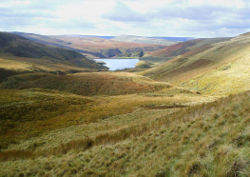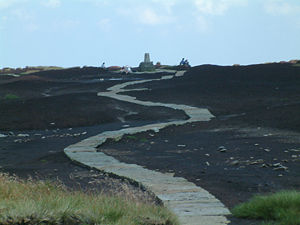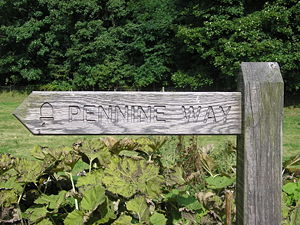Pennine Way
2008/9 Schools Wikipedia Selection. Related subjects: Geography of Great Britain
| Pennine Way | |
|---|---|
 View from the Pennine Way, near Marsden |
|
| Length | 429 km (268 mi) |
| Location | Northern England, United Kingdom |
| Designation | UK National Trail |
| Trailheads | Edale, Derbyshire Kirk Yetholm, Scottish Borders |
| Use | Hiking |
| Highest Point | Cross Fell, 893 m (2,930 ft) |
| Trail Difficulty | Moderate to Strenuous |
| Season | All year |
| Hazards | Severe Weather |
The Pennine Way is a National Trail in England. The trail runs 429 kilometres (268 mi) from Edale, in the northern Derbyshire Peak District, north through the Yorkshire Dales and the Northumberland National Park, to end at Kirk Yetholm, just inside the Scottish border.
History
The path was the idea of the journalist and rambler Tom Stephenson, inspired by similar trails in the United States of America, particularly the Appalachian Trail. Stephenson proposed the concept in an article for the Daily Herald in 1935, and later lobbied Parliament for the creation of an official trail. The final section of the path was declared open in a ceremony held on Malham Moor on 24 April 1965. The path runs along the Pennine hills, sometimes described as the "backbone of England". Although not the United Kingdom's longest trail, it is according to the Ramblers' Association "one of Britain's best known and toughest".
Usage
The Pennine Way has long been popular with walkers, and in 1990 the Countryside Commission reported that 12,000 long-distance walkers and 250,000 day-walkers were using all or part of the trail per year. They furthermore estimated that walkers contributed £2 million (1990) to the local economy along the route, directly maintaining 156 jobs. The popularity of the walk has resulted in substantial erosion to the terrain in places, and steps have been taken to recover its condition, including diverting sections of the route onto firmer ground, and laying flagstones or duckboards in softer areas. These actions have been generally effective in reducing the extent of broken ground, though the intrusion into the natural landscape has at times been the subject of criticism.
A number of Youth Hostels are provided along the route to break up the trek, in addition to many private establishments offering accommodation. It is easy for the walker to undertake just a short section of the trail, with 535 access points (on average, one every half-mile or approximately one kilometre) at which the Pennine Way intersects with other public rights of way.
As the majority of the Pennine Way is routed via public footpaths, access to those sections is denied to travellers on horseback or bicycle. In order to grant them a similar route, a Pennine Bridleway is also now under development (as of autumn 2005, two principal sections are open); the route is generally parallel to the Pennine Way, but starts slightly further south in Derbyshire.
Route
A survey by the National Trails agency reported that a walker covering the entire length of the trail is obliged to navigate 287 gates, 249 timber stiles, 183 stone stiles and 204 bridges. 319 kilometres (198 mi) of the route is on public footpaths, 112 kilometres (70 mi) on public bridleways and 32 kilometres (20 mi) on other public highways. The walker is aided by the provision of 458 waymarks.
The route of the Pennine Way passes close to or through the following places (mountains and moors are marked in italics, towns and villages in normal type):
- Edale
- Kinder Scout
- Bleaklow
- Crowden
- Black Hill
- Wessenden valley
- Saddleworth Moor
- Standedge
- Littleborough
- Stoodley Pike
- Todmorden (for the Caldervale line)
- Hebden Bridge (for the Caldervale line)
- Wadsworth Moor
- Keighley Moor
- Elslack Moor
- Lothersdale
- Gargrave
- Airton
- Malham
- Fountains Fell
- Pen-y-ghent
- Horton in Ribblesdale (on the Settle-Carlisle Railway)
- Dodd Fell Hill
- Hawes (for the Wensleydale Railway)
- Great Shunner Fell
- Kisdon
- Kisdon Force
- Keld
- Tan Hill
- Crosses the A66
- Middleton-in-Teesdale and the Tees valley
- High Cup
- Dufton
- Great Dun Fell
- Cross Fell
- Alston
- Greenhead
- Hadrian's Wall (near the B6318)
- Shitlington Crags
- Bellingham
- Windy Gyle
- The Cheviot
- Kirk Yetholm

